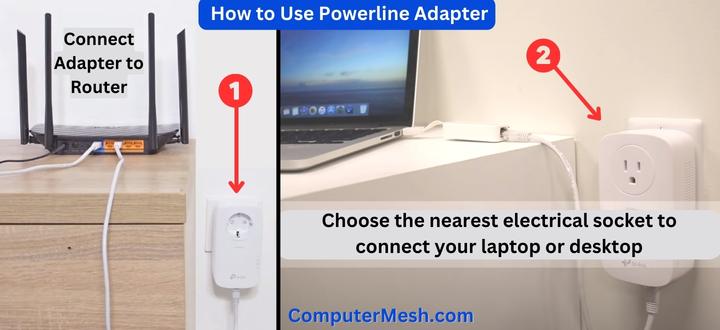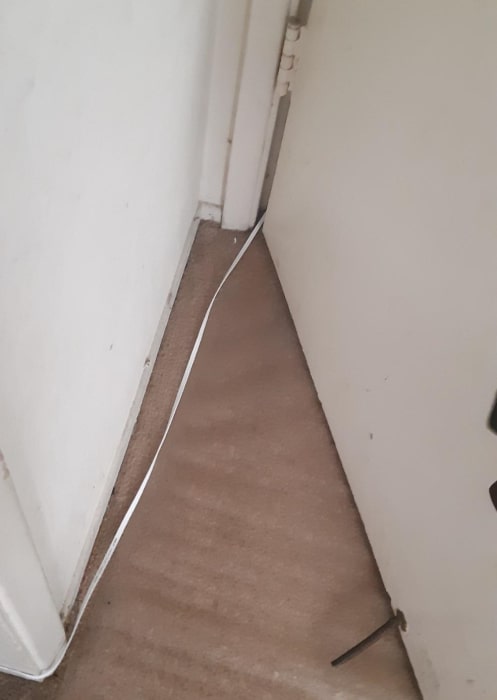How to Get Wired Internet in Another Room of House?
Are you looking for a way how to get ethernet in my room? Or (Ethernet) in every room of your house? Do you need it for gaming, streaming video, or working wherever you feel like it? If so, then this guide is for you!
A wired internet connection (Ethernet) can make all the difference. Many people, including you, might also want to wire every room in the house with an Ethernet cable.
In this guide, you’ll know the process of wiring up your home with Ethernet cables and give insights on what precautions to take and what tools are necessary.
Running ethernet cables through your home is the best way to ensure a stable connection, no matter where you are. Take this as your guide for wiring an ethernet connection throughout your house and experiencing fast internet from any room without needing a separate router.
How to Get Wired Internet in Another room or Every room of House
Why Go Wired? The Benefits & Reasons Of Hardwired Internet Connection
Granted, you have to give up the convenience of wireless-ness. Still, the benefits you gain from a wired connection are far greater. Here are a few of them:
Method 1: Wired Internet Over Powerline Adapters
For Who Don’t Want To Run Ethernet Cables Much
Before laying ethernet cables, here’s an effortless method of getting a wired connection. It won’t be as fast as ethernet, but it will be faster than Wi-Fi. That, too, without the signal limitations and interruptions – the characteristics of a typical Wi-Fi connection, especially when traveling all the way up to the upstairs bedroom.
These powerline devices plug into your electrical outlets, transmitting data from router to PC through the existing electrical lines in your home. These devices typically come as a kit containing two adapters and two ethernet cables.
Remember, For attaching the first adapter choose an electrical outlet to the nearest of your router as well as do not use power strip or extension board, as it can cause problems.
You have to connect your router with first adapter using ethernet cable, it will enable data transmission through the electric lines. And choose an electrical outlet for the second adapter, wherever you want to connect any of your devices (laptop, desktops, SFF PC, Home theater PC, or others) via the inserting ethernet cable into adapter.

You can get more powerline adapters for more devices. TP-Link AV600 Powerline Ethernet adapter is a good one to start looking for powerline adapters for wired connection in your home by reducing cable hassle. Remember to read the instruction manual for precise set up.
Method 2: Running Ethernet Cables
If you want the top speed in every room of your house, which you paid for to your ISP, your best bet is using ethernet cables. You will learn how to visualize, plan, and lay them ahead, but first, let’s go over the tools you will require for this task.
1. Tools Required: Routers, Switches, Ethernet Cables, And Workman Tools
Routers & Switches
A router is the gateway device that connects you to the internet. You already have a router in your home if you can access the internet. However, the thing is, a typical router acts as a 3-in-1 device.
- The actual router part that connects you to the internet via WAN port,
- The switch part that connects multiple devices to the router via LAN port, and
- The wireless access point – is responsible for sending Wi-Fi signals through the router’s antennas via channels width.
Routers are just like a mini-PC, running a particular operating system. However, they are highly underpowered and can quickly get overwhelmed when many devices are connected.
Therefore, while a typical router would have 3-4 ethernet ports. If this isn’t sufficient for your home needs, you can get a switch to add extra ports to your router. For homes, 5, 8, or 12 extra ports are plenty.
Ethernet Cables
Since we are laying ethernet cables, you will obviously need spool(s) of ethernet cables. Before getting multiple LAN cables, first decide how many rooms required to get wired Internet connection with the length (15, 25 or 50 foot).
You will also need an RJ45 crimping tool to connect the ethernet cable to the RJ45 connector along with the outlet.
As for the type of cables, Cat5e and Cat6 are popular today; they can offer speeds up to 1 Gbps and 10 Gbps, respectively. You can also buy the more expensive Cat8 cables that supply speeds up to 25-40 Gbps.
Good to Know ~ It is a good idea to get colored cables as it will help in figuring out what cable to send to which room. Moreover, helps with the troubleshooting part.
Workman Tools
You will need some typical workman tools to help you to set down ethernet cables. Here are some of the tools you will need.
- Cable mount clips – to mount your cables above the floor, somewhere they won’t cause trips
- Tape – to hide cables if they look out of order on wall or floor corners
- Utility knife
- Ethernet (RJ45) connector / LAN socket outlet
- Hammer and nails
- Fish tape
- Wire snake
- Drill machine – if needed, to punch ethernet cable through a wall
2. Visualizing All The Wired Connections And Planning The Route
It is a good practice to first visualize all the areas requiring the wired connection. Plan ahead a few years if you have to because laying down cables isn’t something you might often do.
Get pen and paper and make a rough floorplan of your house; look at the blueprint if you have to. Now mark all the areas, from basement server rooms to the upstairs kitchen (smart refrigerators have been a thing for a while now).
3. Tips for running ethernet cables along the planned route?
With the rough floor plan in your hand, start planning the route for the ethernet cables.
Ideally, you would want the most direct path with the least bends, but you will encounter a few corners while laying the cables; make sure not to do a complete 90° bend cable as it will damage it (else get a flat ethernet cable).

Now, you won’t be running the cables directly from point A to point B, so your best bet is to run them along the walls.
Either you could run them through the top corners of the walls and then cover them with tape to hide them or run them along the skirting at the bottom of the walls.
If its seems difficult you can use cable cover (raceway) to stick on the wall.
4. Laying Down The Ethernet Cables
Running Ethernet Cables Indoor
Now, finally, start laying the cables as you planned. Most of us want the drilling minimum, so you can run them under the carpet, behind furniture, or tape them along baseboards. Here are a few considerations for running ethernet cables indoors:
Running Cables Through The Attic / Crawlspace
If you don’t want to run the cable along the wall or you can’t find the tiny opening in the door or window (here you can get flat cable).
Else, you can use the attic or the crawlspace to run your ethernet spool. Although you might still need to drill a hole through, it is still minimal and not so laborious.
Running Ethernet Cables Outdoor
If you lack an attic or a crawlspace and don’t want the wires cluttering inside your home, you have one more option. You can drill a hole through the wall and run the cable outside your home.
However, remember to take all necessary precautions to protect the ethernet cables from the tough outside environment. It would help if you used cables with extra shielding and sheathing, such as Cat6 or Cat6a cables.
5. How To Run Ethernet Cables Through An Existing Wall?
This can initially seem daunting, but it should be a cakewalk with the right tools and techniques. Here are the steps to follow:
1. Plan the route, avoiding studs, electrical wires, plumbing, etc.
2. Choose the right tools to run ethernet cables through the existing wall. You will need a drywall saw or utility knife, fish tape, and a drill machine with a long drill bit.
3. Cut the hole with the drywall saw or the utility knife.
4. Fish the cable with fish tape. You can also use a wire snake to guide the cable through the wall.
5. After pulling the wire through the hole, install the LAN socket outlet using a wall plate. It looks better than just having a wire running through a hole.
Test The Connection
Regardless of how you run your ethernet wires, the primary purpose is that they should work. So, test every connection for speed and reliability. You can use speedtest.net to test your connection’s ping, and how good is your upload speeds and download speeds.
FAQs
Is ethernet over a powerline better than Wi-Fi?
Ethernet over powerline is relatively better than Wi-Fi, but it also depends on the quality of the electrical wiring. On proper wiring, the connection is more reliable (which isn’t affected by walls and objects) and offers better speeds. Wi-Fi speeds in homes are typically between 5-54 Mbps, while the speed over the powerline is about 100 Mbps.
How do I run an Ethernet cable from downstairs to upstairs?
You can run an ethernet cable from downstairs to upstairs by drilling a hole through the roof of where the router is located to where you want the cable to come out from. Use fish tape to pull the cable through the holes you drilled. If you don’t want to drill, you can run the cable along the walls of the stairs. However, do not bend the cable; otherwise, use flat LAN wires.
Can any electrical socket be used to run ethernet over powerline adapters?
Not all electrical sockets are suitable for running ethernet over powerline adapters. These sockets must be on the same circuit to provide an ethernet connection. Some adapters are designed specifically for European sockets, while others are for US sockets. Also, you can’t attach these adapters to extension boards or power strips as well.
How to crimp ethernet cables?
By crimping, it is meant to close the ethernet cable with an RJ-45 connector so it can be plugged into an ethernet port on a device. It requires a crimping tool as well as some practice. First, strip the outer jacket to expose four twisted pairs of wires. Untwist and trim them to insert them into the connector. Finally, crimp it with the crimping tool.
Wrapping It Up
The way to ensure you get an uninterrupted connection that gives you the total bandwidth you paid for to your ISP is to get a wired internet connection, preferably over ethernet.
A switch is usually not required for typical home connections, but you can get one if you need to extend the number of your router’s ethernet ports, also Gigabit port if you router support those speeds. Of course, you will need an ethernet cable as well.
Before laying down the wires, visualize and plan your route extensively. Keep safe drilling to a minimum and do it only where necessary.
If you can compromise on the speed but need a better connection than Wi-Fi, consider the ethernet over powerline adapter method. You won’t need to lay down ethernet wires for this method. Only install the adapters in electrical sockets, plug your ethernet cable, and you are ready.
With this ends the article on How to Get Ethernet in my Room or every Room of Home?, hope so, it has helped to get the idea of wiring ethernet in space. Remember that you can share it on social networks so that it can help more users who need it.
